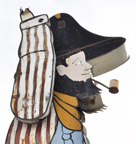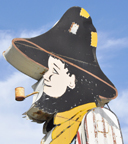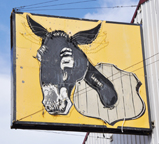
 |
 |
 |
 |
 |
 |
 |
email: roadarch@outlook.com |
 |
| Mechanical Signs (page 2) |
(hit "refresh" to get the most recent version of this page; click on photos for larger images)
| Chief Pontiac Cincinnati, OH |
Chief Diner Durango, CO |
Miracle of America Museum Polson, MT |
|
 |
 |
 |
 |
|
The Chief Pontiac sign is installed in front of MotorTime Auto Sales. The sign was built in 1954 by the Lumilite Neon Sign Company for the Sky Pontiac used car dealership. The dealership was later known as Cherokee Motors. MotorTime has been here since 1981. The Indian sign was originally outlined with neon, the eyes winked, and the arm waved. Although several articles state that the sign is 50 feet tall, it is shorter than that. The Indian is about 15 or 20 feet tall. The sign has been repainted a few times. While it has been said that these signs were produced by General Motors for other Pontiac dealerships, that is a myth. This sign was actually inspired by a waving man sign at Bob Porter's Elmo Club in Billings, MT. This article from a 1955 Signs of the Times magazine covers the history well. For more, see this website. [map]
The Chief Diner opened in 1945 as the Pioneer Diner. It was renamed the Chief Diner in 1947. This sign was clearly inspired by the one in Cincinnati. The Durango Indian sign was built in 1957. It is about 20 feet tall. His arm waved and his eyes flashed. In the mid or late 1950s, the restaurant was renamed the Chief Restaurant and a new sign panel was added below the Indian sign. With the addition to the sign, it was about 50 feet tall. The name on the building was also changed as well. After the restaurant closed in the early 1980s, the sign was purchased by Jackson Clark for $300. I don't know what happened with the totem pole sign which was also removed from the restaurant. For a few years, the Indian sign was displayed in front of his father's Pepsi plant. It still had the Chief Restaurant text panels at that point. While it was there, the Indian held a Pepsi can sign. Later, Clark spent $4,000 to refurbish the sign and move it to his business, the Toh-Atin Gallery. Due to the City's sign height restrictions, the sign panels were removed at that point. The neon was also removed. For more, see this website. [map] The connection between these two Indians signs still remains a mystery. While both signs are about the same size and featured neon and waving arms, they are not identical. The Durango Indian has smaller feet and his legs are not as bowed. The Cincinnati Indian's raised hand is also larger. It seems more likely that the Durango sign was built from a photograph of the Cincinnati sign rather than both signs being built by the same sign shop. The sign at the Miracle of America Museum is not mechanical but I'm including it anyway since it was obviously inspired by one of these signs, mostly likely, the one in Durango. The sign was originally installed at the Blue Bay Resort Restaurant in Polson. It may have been built in the 1970s and is about seven feet tall. [map] |
| Westcraft Flooring Denver, CO |
Skookum [gone] Wenatchee, WA |
|||
 |
 |
 |
 |
 |
|
Westcraft Flooring opened in 1954 and this Indian sign was installed shortly after that. The sign was custom made and features the Indian that was once used as the Mohawk Carpet mascot. The Indian's arms originally moved rapidly up and down, with the drumsticks beating on the drum. His drumsticks originally had red balls on the ends. The sign stopped working many years ago. The owner of the store has been under a lot of pressure in recent years to remove the racially insensitive sign. [map]
The Skookum sign was about 30 feet tall. The Indian Brave mascot advertised for the Skookum Packers' Association, a local organization of apple growers and distributors. In 1921, a sign featuring the Indian was installed on steel scaffolding on the roof of the Wenatchee Hotel. There was also a "Skookum" text panel below the sign. It is believed that the sign was motorized originally. There is documentation from the 1920s of complaints from hotel guests about the squeaking noise that Indian's moving eyes made. If this is the original sign, then it would make it the oldest mechanical sign in existence. When the hotel closed in the 1940s, the Indian sign was moved to the roof of the Skookum warehouse. By 1999, Skookum was long gone and the building was adapted for an Office Depot. During the remodeling, the politically incorrect Indian sign was removed and put in storage. After much public outcry to bring the sign back, the 30-foot-tall sign was restored and reinstalled in 2000. The sign's two panels were displayed in a triangulated manner with the tips of the feathers touching. The Indian's eyes moved back and forth in rapid succession. One of the eyes on each side winked through the use of a panel which moved up and down. By the mid-2000s, the winking panel stopped working and it was not repaired. In 2022, the sign was deemed politically incorrect. It was removed and put in storage. It's unlikely it will be displayed anywhere again. For more, see these websites: 1, 2, and 3. |
| Penny Dog Food Birmingham, AL |
|
| 2007: | 2020: |
 |
 |
|
The Penny Dog Food sign was installed next to the 1st Avenue North viaduct around 1953. The sign is about 25 feet long and 15 feet tall. When functioning, Penny's tail wagged, her tongue lapped at the food in her bowl, and her eyes moved back and forth. In 1997, the sign's motors were turned off when it was feared the wiring could start an electrical fire. The sign never had neon but was lit with spotlights.
Penny Dog Food was the economy brand of the Gold Seal Dog Food Company. The company occupied the building beneath the sign. After Gold Seal went bankrupt in the 1980s, Birmingham Hide and Tallow Co. moved into the building. In 2005, the sign was repainted and the dog's movement was restored. The Birmingham Historical Society presented an award to Birmingham Hide and Tallow for the preservation effort. However, the sign's internal mechanisms failed soon after the restoration and the dog has been still since then. In 2010, Birmingham Hide and Tallow moved to a new location. The owners donated the sign to Regions Field, a new minor league baseball park being built in town. Birmingham Hide and Tallow funded the restoration and relocation of the sign which cost about $20,000. The sign's steel panels were replaced with aluminum replicas. The sign was removed in 2013 and it was installed in the parking lot of Regions Field later that year. The sign is visible from inside and outside of the ballpark. The dog's eyes, tongue and tail are fully operational again. [map] |
| Hillbilly Junction [gone] Willow Springs, MO |
 |
| Mule Trading Post Rolla, MO 2010: |
||
 |
 |
 |
| 2024: | |||
 |
 |
 |
 |
|
The Hillbilly Junction sign was originally installed at the Hillbilly Store which was located near Devils Elbow, MO. That store opened in 1943 and this eight-foot-tall sign was built then or shortly thereafter. It originally had neon and the arms spun. The front of the text panel below the hillbilly read "Welcome." The back read "Thanks, Y'All Kum Back". In 2010, when these photos were taken, the arms were stationary. Around 2014, one of the arms disappeared. The restaurant is and gift shop are closed. The sign was still there in 2016 but gone by 2018.
This hillbilly sign at the Mule Trading Post was built in 1981 for the second Hillbilly Store when it moved to Waynesville, MO. The sign is 28 feet tall. I don't know if it ever had neon. When the store closed in 2000, the sign was sold to an antiques dealer. The Mule Trading Post in Rolla bought the sign in 2007 and had the sign repainted and the spinning arms restored. By 2017, the hillbilly's right hand had blown off and the sign was no longer operational. The store closed in 2021 but the sign remains. In 2025, the building began housing Ole Mule Axes n' Fun. For more, see this video. The Mule Trading Post opened in 1946 as the Mule Rock Shop in in Pacific, MO. The store moved to Rolla in 1957 and the mule sign was built at that time. It was originally installed on the canopy of the Texaco station which was next door. The mule's neon ears wiggled back and forth. For more, see this video. [map] |
| Hawkes Plaza Westbrook, ME |
DT's Package Liquor & Sports Bar Cheyenne, WY |
||
 |
 |
 |
 |
|
The Hawkes Plaza "Walking Man" sign was built in 1962 by the business owner Al Hawkes, his father, and his father's high school students. The 13-foot-tall radio and TV serviceman has swinging arms which create the illusion that the man is walking. The sign stopped operating in 1989 around the time that the store closed. In 2004, Hawkes sold the property. The photo above is from 2009. In 2016, the building reopened as Lenny's at Hawkes Plaza, a restaurant, bar, and live music venue. Just before that, the owner had the sign repainted. The 385 sequential bulbs were also restored. The bulb arrow is lit from the outside tips, towards the middle, and to the point in six phases. The Walking Man is too expensive to run on a regular basis but the owner will turn it on if asked. In 2019, the sign was listed on the National Register of Historic Places. For more, see these websites: 1 and 2. [map]
DT's Package Liquor & Sports Bar, a liquor store and bar, was established in 1937. The bar, named after the owner D.T. Johnson, moved to its current location in the late 1940s. A new building was constructed on the site in 1955. It is believed that this mechanical, rooftop elephant sign (first photo) was installed then along with the pole sign (second photo). The rooftop elephant is about six feet tall and its motorized head moves up and down. The sign has been an easy keeper, requiring only a fan belt replacement every few years. The pole sign and the modern sign (third photo) are located at the Ridge Rd. store. For more, see these websites: 1 and 2. There are also elephant statues at both locations. [map] |
| Boot Barn Cheyenne, WY |
Boot Barn Evanston, WY |
Boot Barn Gallup, NM |
Bull Mountain Grille Billings, MT |
 |
 |
 |
 |
|
These motorized signs were originally built for Corral West Ranchwear. I believe the chain was bought out by Boot Barn around 2008. The horse's legs moved back and forth. The chain had other signs like this but these are the only ones that I know of that still exist.
The Boot Barn sign in Cheyenne is still operational. This store is part of The Wrangler store. For more, see this website. [map] The Boot Barn sign in Evanston might still be be operational. For more, see this website. [map] The Boot Barn sign in Gallup no longer operates. [map] The Bull Mountain Grille sign in Billings still advertised for a Corral West Ranchwear store until 2009 when the restaurant was built. The horse's left front leg was broken off sometime between 2018 and 2021. [map] |
| Sunbeam Bread Pine Bluff, AR |
|
 |
 |
| The Sunbeam Bread billboard was installed around 1942. In 2007, Little Miss Sunbeam was repainted. The girl swings back and forth. The sign and the property on which it is installed is owned by the Flowers Baking Company. The company paid for the sign's restoration in 2019. These photos are from right after that. Before the restoration, the loaf of bread was bigger and there was a small panel on top of the sign that read "Sunbeam." [map] |
| Sunbeam Bread [gone] Fort Wayne, IN |
Young & Bertke Air Systems Co. [gone] Cincinnati, OH |
|
 |
 |
 |
|
This Sunbeam Bread sign was built in 1957. The 36-foot-wide "Endless Bread" sign was installed on the roof of the Perfection Biscuit Company bakery which produced Sunbeam bread. There was originally an image of Little Miss Sunbeam sitting on top of the bread but it was damaged by wind and removed. The sign features a wheel with nine slices of bread which spins to create the illusion of sliced bread piling up on a plate. The company, later known as Aunt Millie's, continued to occupy the building and produce Sunbeam bread. In 2007, the sign was restored with new aluminum and plastic panels. Instead of using paint, the sign company used vinyl film. The digital printing on the sign made it possible to give the bread texture. The bag, plate, and letters were more three-dimensional in appearance. The sign was illuminated at night with spotlights just as it was originally. In 2024, Aunt Millie's moved. In 2025, the sign was removed and put in storage. If a new home cannot be found downtown, the company may reinstall it at their headquarters. For more, see these websites: 1 and 2.
Young & Bertke, a metal fabricating business, was founded in 1920. The company referred to the tin man sign (left photo above) as "YouBert", an abbreviation of Young & Bertke. The sign was built in 1926 and was visible from the upper deck of the former Cincinnati Reds' baseball park, Crosley Field. The company relocated during construction of I-75 and rebuilt the sign. This sign was then destroyed in a storm. The current sign was constructed in 1985. YouBert's animated, walking legs stopped working around 2005 but were restored in 2008. The 18.5-foot-tall sign operated continuously 24 hours, 7 days a week. It is estimated that YouBert covered over 10,000 miles per year. In 2013, the company sold the building and relocated. The mechanical sign was turned off then. By 2014, the hanging sign had been removed but the mechanical sign remained. By 2016, that sign was gone, too. In 2023, it resurfaced and will be heading to the American Sign Museum in Cincinnati. The mechanical "guts" inside the sign were removed and will have to be rebuilt. Here's a short video of the sign in motion. For more, see these websites: 1, 2, and 3. |
| former Helen's Children's Wear Burnaby, BC |
||
 |
 |
 |
| The Helen's Children's Wear sign was built in 1956. It features a six-foot-long panel with a girl that swings back and forth. After the store closed in 2006, the City purchased the sign. In 2007, it was removed and adapted. The text was changed from "Helen's" to "Heights" to reflect the Burnaby Heights shopping district where the sign is located. For more, see these websites: 1 and 2. [map] |
| Baird's Drive-in Dry Cleaning Boise, ID |
|||
| 2008: | 2014: | 2022: | |
 |
 |
 |
 |
| In 1947, a motorized washer woman was installed on top of the Baird's Drive-in Dry Cleaning sign. The five-foot-tall statue is made of plywood, chicken wire, and foam. The washer woman's upper torso moves up and down as if she is scrubbing laundry in a tub. Her handmade clothes are changed with the seasons. She has gone by many names over the years but is currently known as Betty. Her motor stopped working around 1990 and the laundromat closed in 2000. In 2007, the building's new owner had Betty restored and the sign panels beneath her replaced with new ones for the building's current occupant, the Cucina di Paolo restaurant. The statue's joints were replaced and a new animated feature was added. Betty's head now turns to the right in conjunction with her upper body movement. She stops working around midnight and whenever the temperature reaches 100 degrees. The building now houses American Pizza. In 2025, the city is planning to designate Betty as a local landmark. For more, see these websites: 1 and 2. [map] |
| E.H. Roberts Co. [gone] Elyria, OH |
 |
| This E.H. Roberts Co. mechanical sign featured a man rocking back and forth in his chair. The "Rocking Man" sign was built in 1955. It was removed in 2017 when the property was put up for sale. For more, see this video. |
|
More Mechanical Signs:
Van de Kamp's Bakery (Alameda, CA) Double D Liquor (Douglas, WY) |
|
Mechanical Signs page 1 |
Main SCA Article Companion Page |
Main Signs Page |
| RoadsideArchitecture.com |
Copyright. All photos at this website are copyrighted and may only be used with my consent. This includes posting them at Facebook, Pinterest, blogs, other websites, personal use, etc. Tips & Updates. If you have suggestions about places that I haven't covered, historical info, or updates about places/things that have been remodeled or removed, I'd love to hear from you: roadarch@outlook.com. |